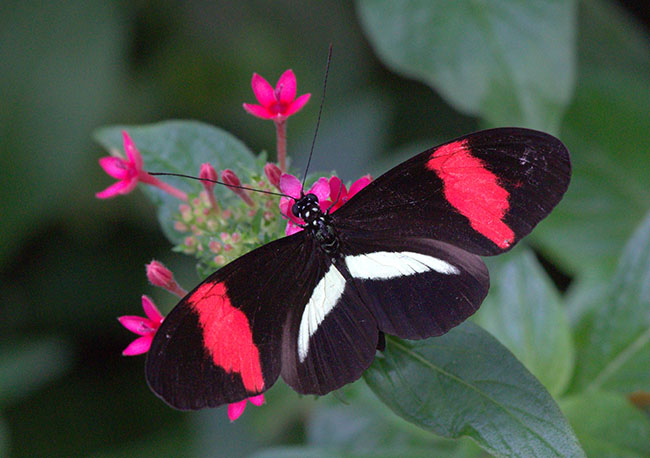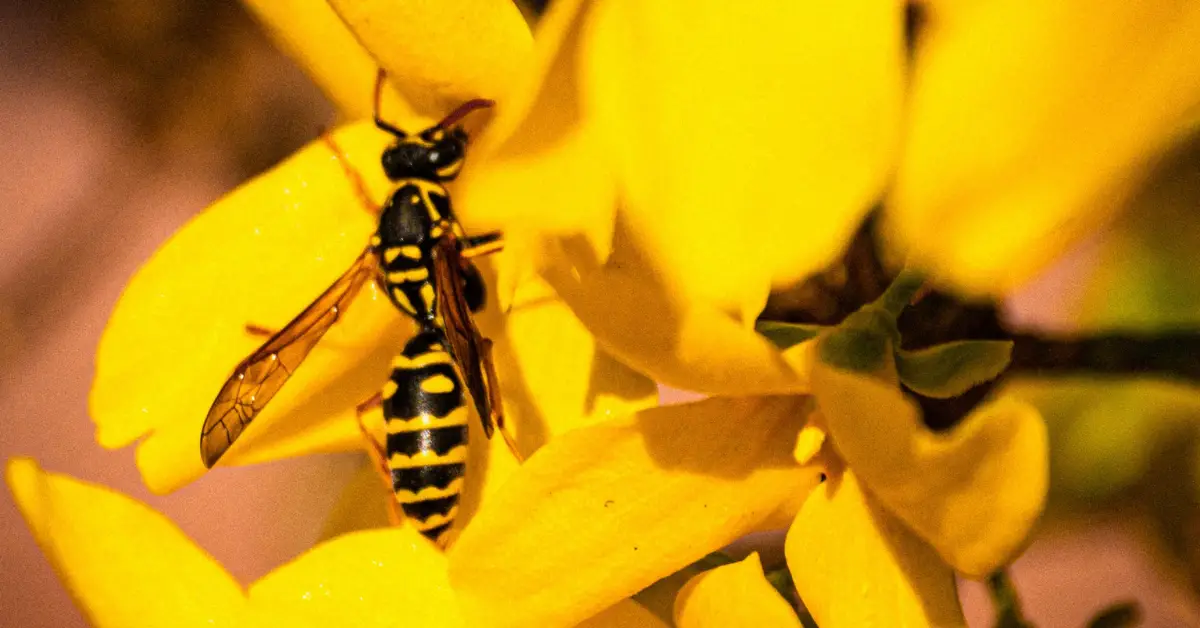Black and white butterfly species
Butterflies make your garden and surrounding a colorful place with the blending of flower’s color. Observing a solid color butterfly in your backyard is a rare opportunity. Because most butterflies have at least a bicolor combination or multi-color appearance on their body. However, black and white butterfly species are most common in nature. They also have some other colors on their wings.
Here is the collection of worldwide black and white Butterfly species which may already have in your garden. Some species have colors on the wings mixed up with black and white. However, their predominant appearance is black and white.
1. Zebra swallowtail
This long-tailed butterfly has a fantastic sight when docking and flying. It appears just like a two-long-tailed kite. Right before the tail, the hind wings have red velvet stripes with black and yellow borders while the wingspan is averagely 2,5 – 4 inches. Swampy areas are their favorite for breeding and laying eggs. They tend to feed on nectars in brushy areas and open environments. They have shorter proboscis than other swallowtail butterflies, so they tend to feed on flatter and more ephemeral blooms in the fields. Zebra swallowtail would have 2-3 broods each year where it comes out firstly in the spring. It’s a beautiful yet pampering experience to enjoy Zebra Swallowtail in the garden or open fields.
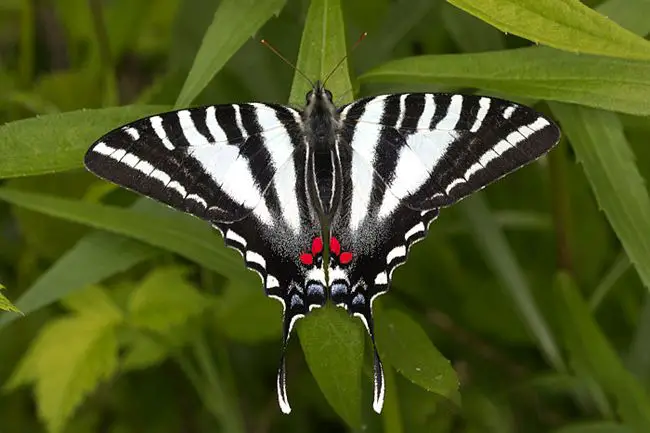
2. Marbled White
The name stands for its marbled black and white butterfly pattern across the outer and hind winds. Marbled white butterflies typically prefer purple flowers to feed, and they might be found in gardens or flowery grassland. They have medium size ranges from 53-58mm, an average measurement of the brown family. Eggs and adults have strong growth in July and August. Adults like grassy areas while they are consumables for the larvae. Therefore, Marble white butterflies can easily be found in urban-rural areas.
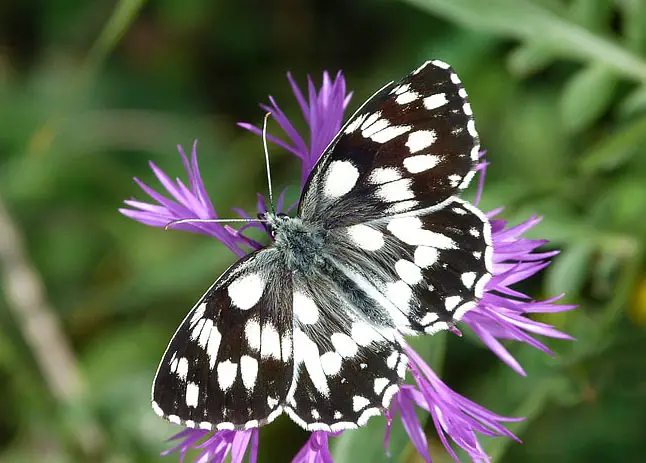
3. White Admiral
White Admiral butterflies are from the Nymphalids family and are recognizable with their white-banded black wings similar to Purple Emperor butterflies except for their monochrome appearance with long glides and rapid wing beats. Adult White Admiral prefers feeding nectar on Bramble flowers and gets along with the sunlight very well. We can see this butterfly in medium or large size with a wingspan of 60-64mm. They prefer shady woodland with sunny glades where Bramble flowers are available for nectar. Unfortunately, the White Admiral butterflies’ population has been declining significantly for the last two decades with a high butterfly conservation priority.
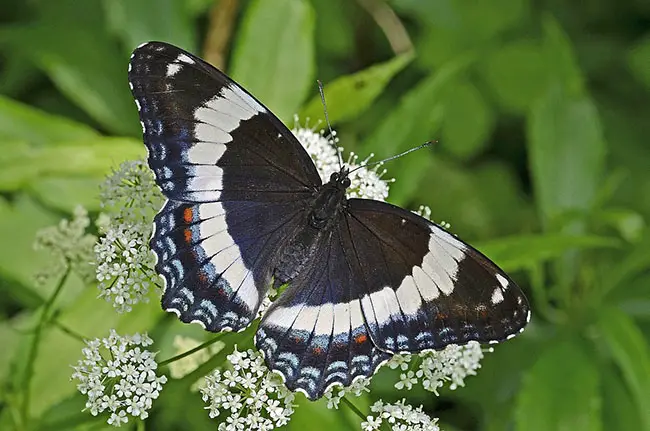
4. Large White
Large White is undoubtedly a remarkable butterfly with dominant white wings and black tips on the forewings for their female. They’re merely large (63-70mm) with pure white hind wings. They have two longer life cycles from May to July, with June as the peak, with August and September. Large White isn’t picky when it comes to habitat, as you can find them on gardens or farms with grown cabbages. These Large White butterflies are appealing even when seen in the open field due to the dominant white color and large size.
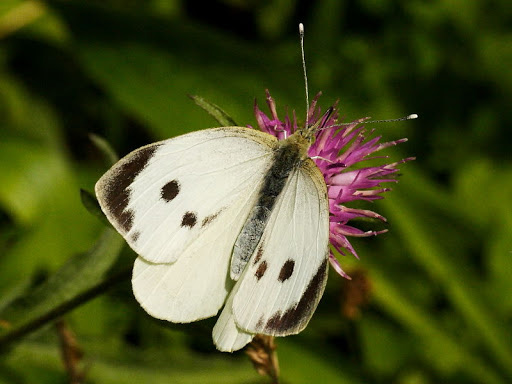
5. Grizzled Skipper
It’s a spring butterfly from the Skippers family known for its “feathery” wings drizzled with white spots, but considerable symmetrical for both sets or called checkerboard patterns. Even though it has a significantly small size(27mm), the Grizzled Skipper butterfly is recognizable with its wing pattern. Their colony usually take vegetated habitats with flowers for them to feed on. It has rapid wing beats and agile flight, but you can adore them when they’re settling on flowers as they would spend some time when feeding on. However, the number of Black and White butterflies is currently declining with a high butterfly conservation priority.
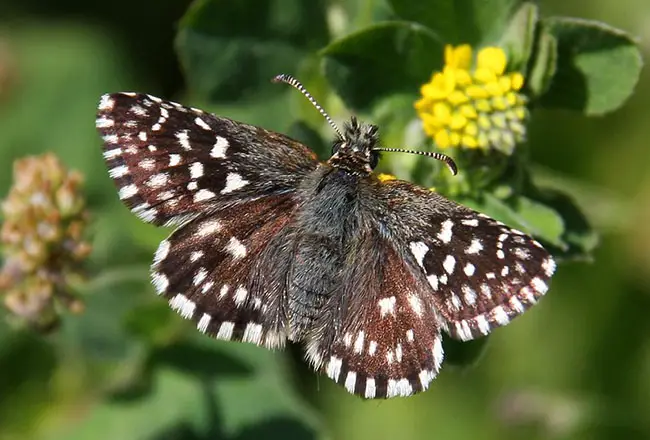
6. Wood White
Wood White appears in white-dominant color with rounded-edged forewing and minor gray marking. At a glance, they look like merely albino butterflies while someone sprays some gray-colored painting. While the females feed on flowers and rest most of the time, the males spend most of their days finding a mate in fine weather. Wood White is a medium-sized butterfly with 42 mm of the wingspan range. They typically live in tall and partially shaded grassland or simply woodland. In urban-rural areas, they can be found in grassy areas or non-operating railway lines. Even though not threatened, Wood White is currently in the high butterfly conservation priority.
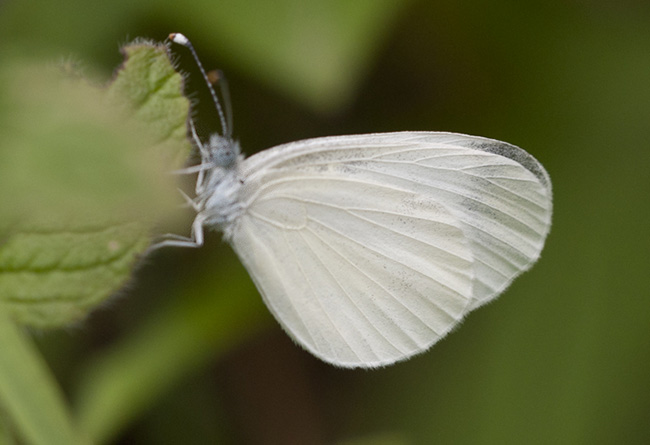
7. Black Swallowtail
They are larger Black and White Butterflies from Swallowtail families and usually live in open areas, gardens, and the top of the hills. Anise butterflies are native to the Western North American territories. The upper and lower side of the wing is black while the upper wing has a broad yellow stripe. They feed on long-tubed flowers of the taller plants like Butterfly Bush, Red Clover, Common Milkweed, and so forth. The Black male Swallowtail could be territorial in the area they’ve marked for searching for a mate.
They look like Spicebush or Black Swallowtail butterflies. Black swallowtail caterpillar has a gland behind the head, which use as a defense system. It emits a foul smell to keep the potential enemies away. Inviting them to your garden would pamper your view, but you’d need to provide those taller plants for nectars. On the other hand, you may need to keep it more open instead of shady.

8. White Morpho
White Morphine is a fantastic butterfly with an elegant appearance. The wings are clean white, slightly translucent with vaguely appeared veins & spines and black/brown eyelets. You can easily see their structure when resting on plants for nectars. White Morpho butterflies love overripe fruits, and that’s all they would consume. They’re super large and easily noticeable due to the appealing regal wings. White Morpho butterflies’ primary habitat is the tropical area, but they’ve become a rare species. There’s no way to invite these super gorgeous butterflies if you’re living in four-season countries.
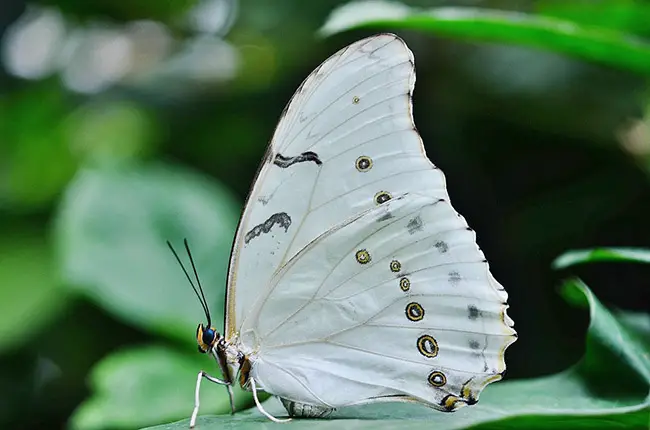
9. Checkered White
Checkered white butterflies enjoy fields or grassy places very much. They’re small butterflies with dominant white wings. While the male butterflies have minor symmetrical checkered patterns, the female butterflies’ wing patterns are way more checkered, making the white colorless prevalent. You may also find checkered white butterflies in road edges, but they’re considerably quick fliers. They feed on Cardinal flowers, Hibiscus flowers, and Lantana whenever served in the habitat. Checkered White butterflies can be found in most states in the described environment. You may invite them into your backyard or garden as long as it’s open space.
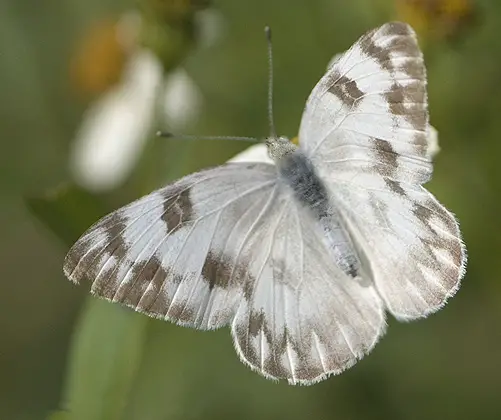
10. Cabbage White
Cabbage White butterflies are from the Whites and Sulphurs family with small to medium size. These butterflies can be found in open fields, suburbs, or any garden with major vegetable plants. They have a set of two identical wings with round-shaped edges with black tips on the outer corner. While the male appears exactly as described, the females may have mono cream colors that make them very different from their mating partners. Cabbage White loves Red Clover, Aster, Tall Verbena, and Cosmos flower plants. If you have vegetable gardens or open fields in your property area, you can likely invite these butterflies.

11. Great Southern White
Great Southern White butterflies love open areas, and you may find them in gardens or marshes. Their wings are dominantly white with black borders on the forewings while the downsides remain plain. Their antennas are black with white tips while the upper body is rather gray but has white downsides. That describes male Great Southern White butterflies well, but the females have a greyer set of wings. They’re medium-sized butterflies that love to enjoy nectar plants like Tall Verbena and Lantana. Like their name, these butterflies are only found in the southern part of the country, including Florida, Louisiana, and Texas.
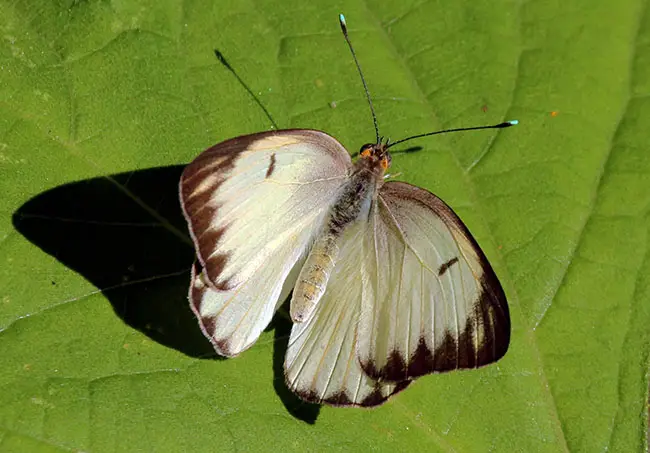
12. Zebra Longwing
Zebra Longwing has descriptions in its name where the black body and wings are striped with yellow stripes. The wings can open so long from the body’s center as they can reach up to 4 inches long. It comes from a brush-footed butterfly family. While they love shady spots for relaxing, their habitats include forest edges and open woodlands. They consume a wide array of nectar plants, including Salvia, Lantana, Butterfly Bush, Verbena, and Butterfly Milkweed. You can invite this black and white butterfly into your garden if you can create that shady environment for them.
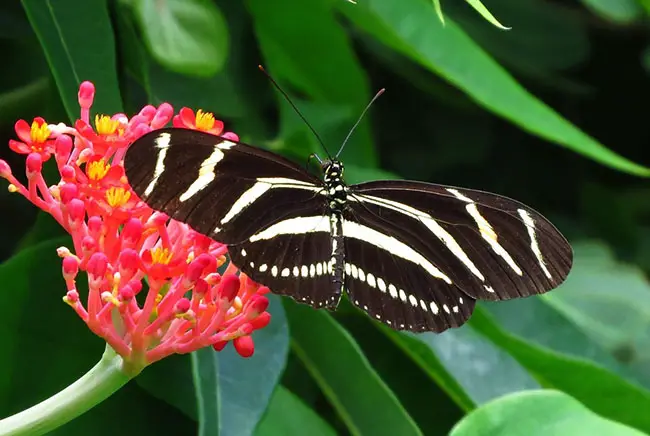
13. Atala Butterfly
Atala is a unique butterfly from the Gossamer Wing family with a considerably short wingspan. These butterflies have the hairstyle on their wings, just like their subfamily (Theclinae). Half of the body is orange, and the checker white-blue pattern appears massively in the wings’ downsides. While they enjoy living in tropical lowlands and open woodlands, Atala butterflies can also be found in the suburbs as long as they can feed on Lantana Plants. The colony of Atala butterflies is very limited, like the ones you can find in southern Florida. It seems hard to invite Atala butterflies into other areas.
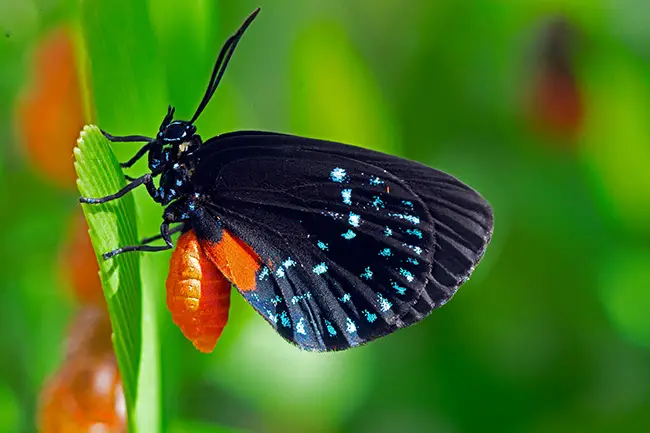
14. Anise Swallowtail
Anise Swallowtail is a great swallowtail butterfly where the males love hill-topping very much, searching for a mate. They are scientifically named Papilio zelicaon. Anise butterflies can distinguish by other swallowtails with their relatively small wings and lack of vertical black stripes on the wings. Red eyespot can be seen on the lower wings’ edge with black color pupil on center. They’re territorial butterflies with larger sizes and more extended proboscis so that they can find nectar tubed flowers and taller plants with no problems. They can be found on Butterfly Bush, common milkweed, Butterfly milkweed, red clover, and so forth. You can find Anise Swallowtail in the hills, open areas, and gardens with those plants.
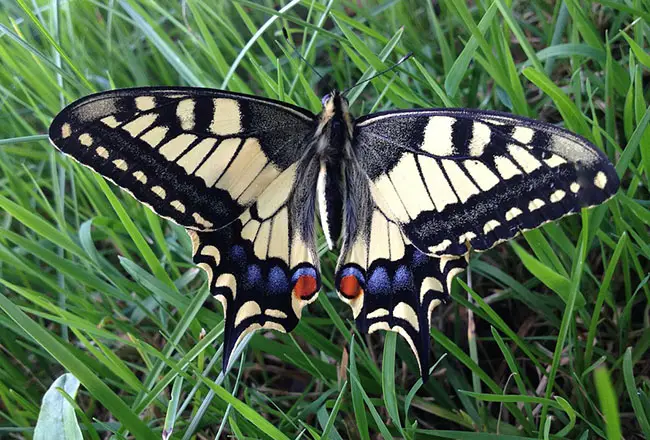
15. Spicebush Swallowtail
This super gorgeous Black and White Butterfly has a solid black body, visible white veins, white eye spots coming to the edges, and shiny wings with green or blue shades on the hind wings. The wings’ undersides are occupied with white-bordered orange spots that make it look different when viewed from above. Spicebush Swallowtail butterflies feed on a wide range of plants like sunflower, Butterfly Bush, some weed plants (Milkweed), Salvia, Pincushion Flower, Lantana, Buttercup flower, and so forth. They can be found in parking areas, swamps, wooden areas, and even any garden. Fortunately, these eye-pampering butterflies aren’t picky in the environment, so that you can invite them into your garden with no problem.
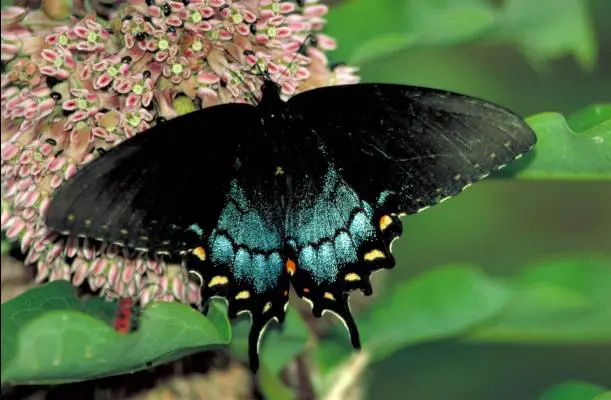
16. Common Sootywing
Common Sootywing is a small butterfly from the Skipper family with shiny black wings shaded to the edges and the body. There are white spots on both forewings and hind wings. These butterflies feed on various flowers like white clover, dogbane, oxalis, and so forth. You can see the males flying zigzags when looking for mates, and they don’t get bothered by crowds. Common Sootywing can be found in pastures, fields, gardens, and even road edges. This way, you can invite Common Sootywing butterflies to your backyard or garden more easily.
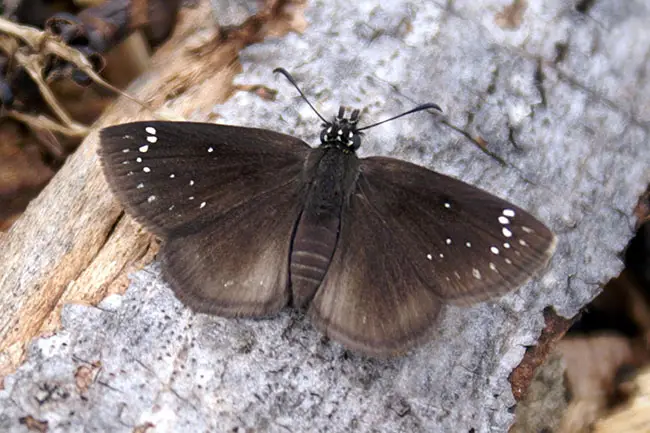
17. Desert Cloudywing
Desert Cloudywing is a skipper butterfly that can be found in open woodland or grassland areas. They have a set of small cloudy wings that make their body look more prominent. They’re working hard in feeding on delicious nectar, so you can easily find them docking on flowers, moving to others, and so on. These small butterflies aren’t picky on the plant as they can live in diverse environments. As they keep skipping flowers for nectars, your flower gardens would be so inviting for them. Desert Cloudywing may dock on the pond to tip nutrients once for a while.
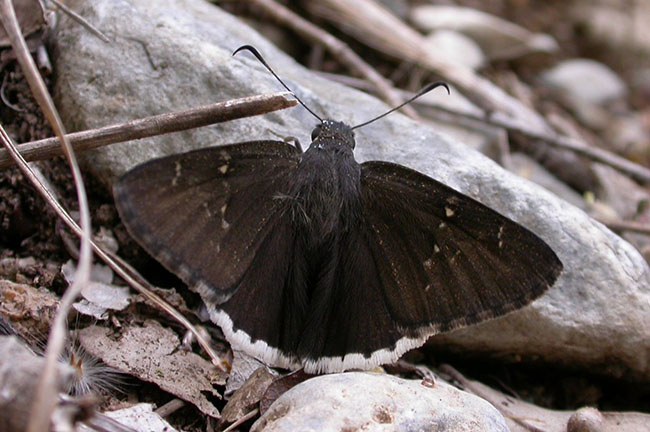
18. Common Eggfly Butterfly
The Common Eggfly butterfly or blue moon butterfly lives in Australia, Asia, South Pacific Islands, and Madagascar. Males and females are similar in undersides except that males have darker colors. However, they’re entirely different in the upper sides where males have black wings with purple/blue-shaded white patterns while females have dark brown wings with patterns in the edges. The “egg” word refers to egg spots owned by the males absent in the female’s wings. This black-white and blue butterfly can be found in woodlands, grassland, or green gardens as long as they can feed on common nettle or Mallow.
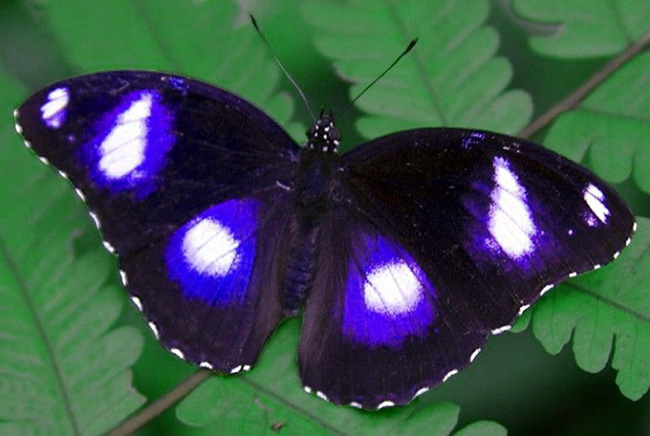
19. Common Pierrot
Common Pierrot is a small butterfly species found in India, Sri Lanka, Myanmar, and Indonesia. These males and females are distinctive, especially on the upper sides of their wings. They both have black borders on the four margins, but the males have a white-dominant upper side while the females have a black/brown-dominant upperside. The underside of the wings is primarily white with elongate spots. They are common in open vegetation, wastelands, lower hills, and forests. These butterflies feed on the nectar of herbs and shrubs where they’re flying around in the daylight. Common Pierrot is currently legally protected with WPA-I status.

20. Elbowed Pierrot
Elbowed Pierrot is another Black and White Butterfly from the Lycaenidae family with predominantly black wings with broad white bands on two sets. Both forewings and hindwings have black/brown borders. Elbowed Pierrot colonies are in South East Asia countries and India, while the biggest natural reservation could have been in Singapore. They’re small butterflies that love the moist spots and typically fly close to the ground to puddle on bird droppings(the males). However, Elbowed Pierrot butterflies also visit flowers on sunny days. The floor of the forest is also their favorite place to settle in the daylight.

21. Red Pierrot Butterfly
The Red Pierrot butterfly has a striking black color with white tips on the border and an orange portion on the upper side’s hind wings. When flipping their wings, you can white forewings with black spots and hindwings with black spots and white-spotted orange bands. They’re small butterflies that commonly exist in South East Asia and India. Red Pierrot butterflies can be found in pretty much anywhere with grown wildflowers, including in the gardens, forests, evergreen patches, and so forth. They would love to nectar flowers of herbs throughout the green patches from morning to evening. These butterflies are weak fliers as you’d find them closer to the ground, consuming nectar from short plants.
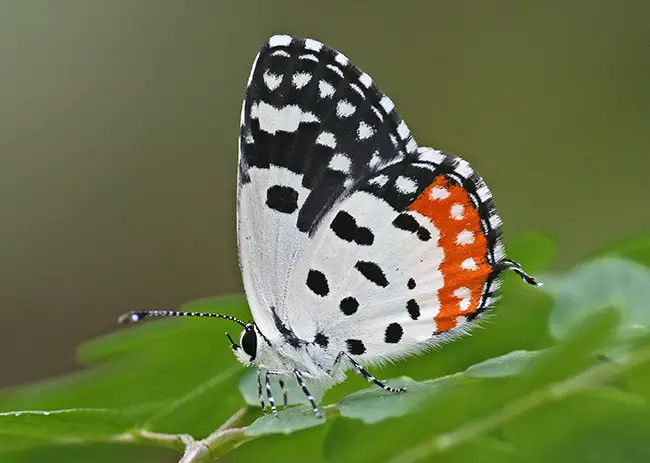
22. Malabar tree-nymph
Malabar tree-nymph is a super distinctive black and white butterfly with tree-like branched black veins and leaf-like black spots on their ends and the wing edges. The wings are predominantly white that makes the whole appearance like a branched tree silhouette. They’re weak fliers and tend to glide whenever possible, just like a kite; well, the paper kite is also their famous name. They fly and drift lower in the forest openings for settlements and nutrients. Malabar tree-nymph is a large butterfly living in India. They’re very noticeable due to appealing black veins on white wing backgrounds and, of course, the large size(up to 154mm).
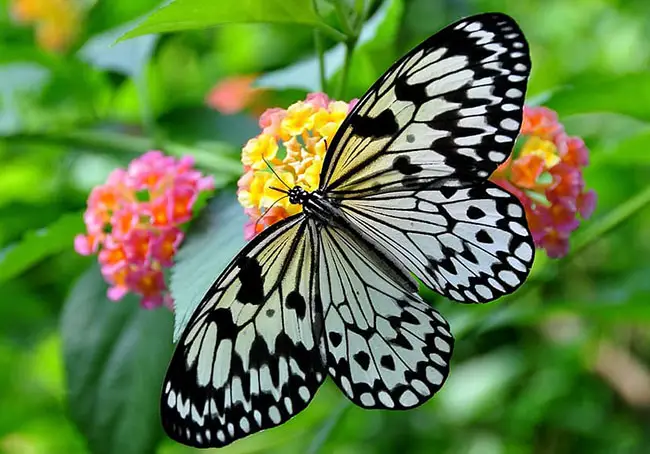
23. Blue Mormon
Blue Mormon is a fantastic swallowtail butterfly coming in large size and streaky sets of wings. The hindwing hosts peacock-style ornaments with white background and dark blue eyespots. Underside wings show the upperside’s reflection, except there are small red patches near the wing attachment. They can be found in wooded urban areas, forests, and any area with heavy rainfall. Males tend to avoid shades and hunt nectar from various flowers in open spaces with sun exposure. They are rapid fliers but with no flight path that makes them unpredictable and hard to catch even though being more tolerant to humans and other butterflies.
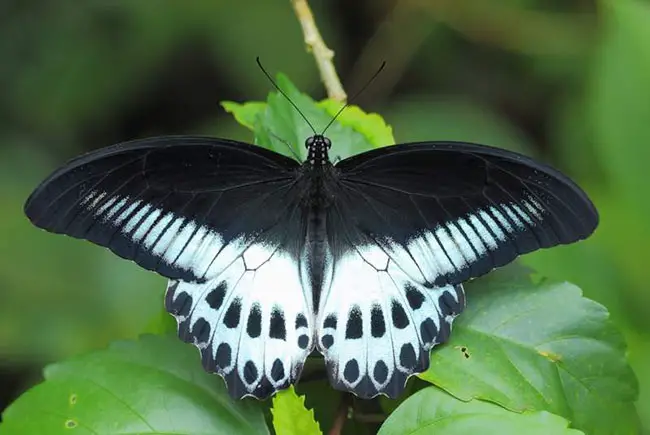
24. Common sailor
The Common Sailor is a nymphalid butterfly that appears in two forms depending on the season. The Upper Side of the wings is black with white markings that make them very recognizable and familiar in India, Nepal, Sri Lanka, Indonesia, Myanmar, and other South East Asia countries. When the wet or rainy season comes, Common Sailor butterflies will get darker while the white markings get narrower. As well as, the underside of the wings is golden with white markings that reflect the upper side. They love sunbathing and nectar flowers or ripening fruits. The “Sailor” word refers to their flying style that looks like slow sailing.

25. Common Mormon
Common Mormon is a Swallowtail Black and White Butterfly with mimicry ability. The wings’ upper side is dark, with blurred white veins and elongated white spots on the hindwings. The primary forms of common Mormon butterflies would vary depending on the climate in the region. These butterflies have a genetic aberration called gynandromorphs that make them genetically altering for each other. They’re a regular garden visitor even though hills and lightly wooded country are also preferable for these butterflies. They keep their flight low, no more than ten feet most of the time. Common Mormon butterflies typically feed on lime or orange plants and nectar long tubed flowers thanks to their long proboscis.
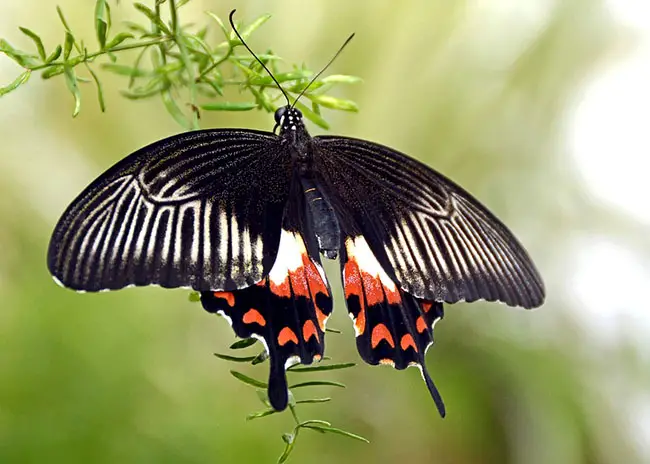
26. Malachite Butterfly
Malachite is an adorable Brush-Footed Butterfly with unique lime green wings with black stripes that shine when catching the sun. The orange highlighting on the underside of the wing gives stunning edges. They’re undoubtedly large butterflies as their wingspan can reach up to 4”. Malachite butterflies feed on overripe fruit for nectars, so it wouldn’t be too difficult to invite them into your garden. They’re strong-flying butterflies and typically live in tropical hammocks. The incredible coloring and the large size make them noticeable even though they sometimes settle in greens. Malachite isn’t a shady butterfly; they love the sun that exposes their beautiful forms all the way through.

27. Doris longwing
Doris is one of 71 Heliconius species that’s renowned for its longwings. Heliconius Doris butterflies are the ones that are common in Mexico to Bolivia. Their super broad wings are predominantly black with white ornaments cutting through the veins and the incredible red or white streaks occupying the half of the hind wing. This butterfly love sunlight exposure in their journey of nectars on Lantana flowers. The interesting fact is that Heliconius Doris can live up to 9 months after morphing. Female butterflies also collect pollen from Psychotic and Psiguria flowers for egging and to prolong their life. They enjoy forest clearing environments with sunlight exposure in the daylight.

28. Eueides Butterfly
Eueides is a butterfly genus of Heliconiinae in the family Nymphalidae. The famous black-and-white butterfly of this genus is Euides Heliconioides that can be found in Bolivia, Peru, and Ecuador. However, these butterflies appear in broad black/dark brown wings with white stripes cutting through the dark veins. They’re rainforest species and live in a lowland. These butterflies like to nectar on Psiguria and Lantana flowers even though they would love to settle in the forest. They would visit moist spots to process minerals they’ve gathered to support the quality eff production. Eueides has at least 12 more species with similar size but wing ornaments that are distinctive to each other.

29. Heliconius Antiochus
Heliconius Antiochus is another longwing Nymphalidae butterfly that can be found in the Amazon region. It appears with broad blue-black wings where the fore wings host a pair of white stripes that stretch between the border while the hindwings are solidly black with a brown upper margin border. Their natural habitat is the riparian forests with the yearly raining season. Adult Heliconius Antiochus butterflies fly slowly to feeding on flowers. This butterfly species has four races, including Antiochus, Aranea, Araneides, and Salvini, distinguished by the bands and patterns. Heliconius Antiochus has a broader distribution area than Heliconius Hewitsoni does in the region.

30. Red postman
Red Postman is a Heliconius Black and White Butterfly that hosts crimson flower patches on their fore wings and white stripes on the hind wings. This remarkable black and white with red butterfly feed on nectar and pollen from Lantana flowers. They would prefer pollen over nectar as they need to extract it into amino acids to support their egg production. These red postman butterflies can coil and uncoil their proboscis to proceed with the nutrients they’ve collected. This Red Postman would be roosting in a small group of the same species and other Heliconius butterflies whenever available. These butterflies exist in Trinidad, Paraguay, Argentina, and southern Texas.
